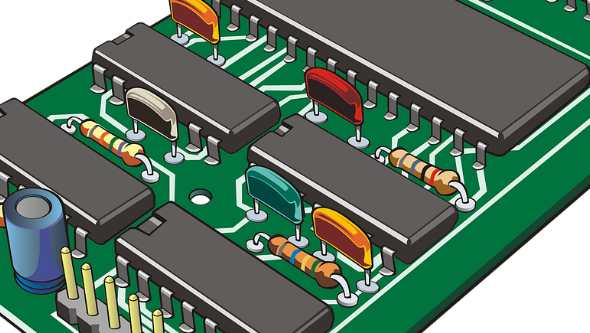
Analysis of the three main reasons for PCB copper dumping
PCB copper wire falling off (also often said copper dumping) is bad, PCB factories are said to be the problem of laminate, requiring its production factory to bear bad losses. According to my years of customer complaint handling experience, PCB factory copper dumping common reasons are as follows:
1. PCB factory manufacturing process factors:
1, copper foil etching is excessive, electrolytic copper foil used on the market is generally single-side galvanized (commonly known as gray foil) and single-side plated copper (commonly known as red foil), common copper is generally more than 70um galvanized copper foil, red foil and 18um below the basic ash foil has not been a batch of copper. When the customer line design is better than the etching line, if the copper foil specifications are changed and the etching parameters are not changed, the residence time of copper foil in the etching liquid is too long. Because zinc is an active metal, when the copper wire on PCB is soaked in etching liquid for a long time, it will lead to excessive side erosion of the line, resulting in some fine line backing zinc layer is completely reacted off and separated from the substrate, that is, the copper wire falls off. There is also a situation that PCB etching parameters have no problem, but after etching washing, and poor drying, resulting in copper wire is also in PCB surface residual etching liquid surrounded, a long time without treatment, will also produce excessive copper wire side erosion and copper. This situation is generally manifested as concentrated on the fine line, or in the wet weather period, the whole PCB will appear similar bad, strip the copper wire to see its contact surface with the base (namely, the so-called coarse surface) color has changed, and the normal copper foil color is not the same, see is the bottom of the original copper color, thick line copper foil peeling strength is normal.
2. Local collision occurs in PCB process, and the copper wire is separated from the substrate by external mechanical force. This defect manifests as poor positioning or orientation, falling copper wire will have obvious distortion, or in the same direction of the scratch/impact mark. Peel off the bad part of the copper wire to see the copper foil surface, you can see the normal color of the copper foil surface, there will be no bad side erosion, copper foil peeling strength is normal.
3, PCB circuit design is not reasonable, with thick copper foil design of too thin line, will also cause excessive line etching and copper.

Two, laminate process reasons:
Under normal circumstances, as long as the hot pressing high temperature section of laminate more than 30 minutes, copper foil and semi-cured sheet is basically combined completely, so pressing generally will not affect the binding force of copper foil and substrate in laminate. However, in the process of laminate stacking and stacking, if PP pollution or copper foil surface damage, it will also lead to insufficient bonding force between copper foil and substrate after laminate, resulting in positioning (only for the large plate) or sporadic copper wire loss, but the stripping strength of copper foil near the stripping line will not be abnormal.
Three, laminate raw material reasons:
1, it is mentioned above that ordinary electrolytic copper foil is galvanized or copper-plated products, if the peak value of the wool foil production is abnormal, or galvanized/copper plating, coating dendritic poor, resulting in the peeling strength of copper foil itself is not enough, the bad foil pressed board made of PCB plug-in in the electronics factory, copper wire will fall off by external impact. This kind of bad stripping copper wire copper foil surface (that is, contact surface with the substrate) after the obvious side erosion, but the whole surface of copper foil stripping strength will be very poor.
2. Poor adaptability of copper foil and resin: some laminates with special properties are used now, such as HTg board, because the resin system is not the same, the curing agent is generally PN resin, resin molecular chain structure is simple, low crosslinking degree when curing, is bound to use special peak copper foil and match. When the production of laminate using copper foil and the resin system does not match, resulting in sheet metal foil peeling strength is not enough, plug-in will also appear bad copper wire shedding.
The quality of nickel layer mainly depends on the formula of nickel plating solution and the control of temperature during chemical deposition, of course, it also has a certain relationship with the process of acidic gold water treatment. The electroless nickel plating process is through the autocatalytic reaction of phosphate and nickel salt on the surface of the pad to obtain the coating, the coating will contain a certain amount of phosphorus (P), many studies show that the normal proportion of phosphorus (P) in the coating should be between 7% and 10%, if the plating solution formula is not maintained immediately or the temperature is out of control, the content of phosphorus will deviate from the normal range. When the phosphorus content is low, the coating will be very vulnerable to corrosion, which first comes from acid gold water etching; When the content of phosphorus is high, the hardness of the coating will increase significantly, resulting in the decline of its weldability, but also seriously affect the formation of reliable solder joints.
If the phosphorus content in the nickel coating is low, and the chemical replacement reaction is not handled well when gold plating, if a large number of cracked gold coating, acid gold water is not easy to remove in the subsequent cleaning process, will lead to the corrosion of exposed nickel coating in the air accelerated, and ultimately the formation of black nickel, the so-called black welding pad generation.









